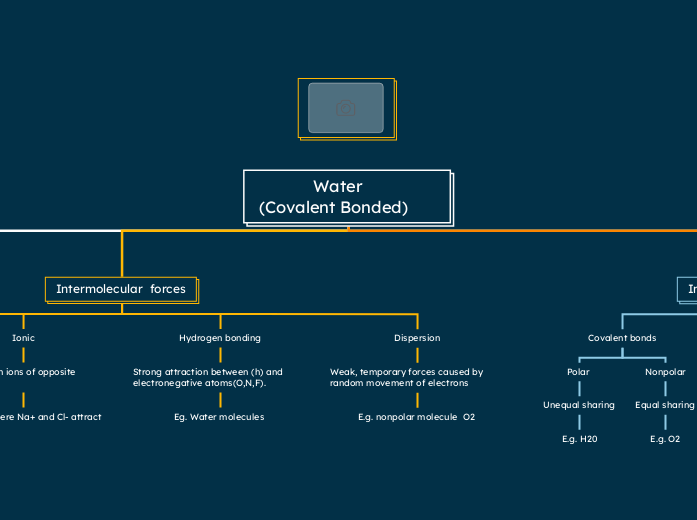Water (Covalent Bonded)
Functional groups Definition: A group of atoms responsible for certain properties of a molecule.

Examples
Hydroxyl (-OH)
Found in: Carbohydrates and alcohols
Example: Ethanol in alcoholic beverages
Properties: Polar and can form hydrogen bonds.
Carbonyl
Aldehyde (-C=O)
Found in: Aldoses and formaldehyde
Example: Propanol
Properties: Polar reactive, and can participate in hydrogen bonding.
Ketones (-C=O)
Found in: Ketoses
Example: Acetone
Properties: Polar and reactive
Carboxyl (-COOH)
Found in: Proteins
Example: Acetic acid which is what gives vinegar its sour taste.
Properties: Acidic and can donate a hydrogen bonds.
Amino (-NH2)
Found in: Proteins
Example: Glycine
Properties: Acts as a base for H+
Phosphate (-PO4)
Found in: DNA and ATP
Example: Glycerol phosphate
Properties: Contributes negatively charged energy transfer. Has the potential to react with water
Sulfhydryl (-SH)
Found in: Amino acids
Example: Cysteine
Properties: Forms disulfide bonds
Intermolecular forces
Dipole
Partial positive and negative charges due to uneven electron distribution
Eg. water has a positive H side and a negative O side
Ionic
Bonds between ions of opposite charges
Eg: NaCl, where Na+ and Cl- attract
Hydrogen bonding
Strong attraction between (h) and electronegative atoms(O,N,F).
Eg. Water molecules
Dispersion
Weak, temporary forces caused by random movement of electrons
E.g. nonpolar molecule O2
Intramolecular forces
Covalent bonds
Polar
Unequal sharing
E.g. H20
Nonpolar
Equal sharing
E.g. O2
Ionic Bonds
Electron transfer
E.g. NaCl
Metallic Bonds
Positive metal ion interaction
E.g. Fe
Main properties of water
Cohesion
Attraction of water molecules to each other
H-Bonds
Surface tension
Spherical droplets
Adhesion
Attraction of water molecules to other things
Capillary action
Water droplets stick to surface
Universal solvent
Polar substances (dissolvable)
Miscible
Hydrophillic
Water loving
Non polar substances (undissolvable)
Immiscible
Hydrophobic
Water hating
E.g. Dissociation of NaCl
High specific heat of vaporization
Energy required to heat substance
Water = high specific heat capacity
Help moderate air temperature in bodies of water
Helps organisms maintain constant body temperature
Density
Soild water is less dense than liquid water
Ice lattice
Hydrogen bonds keep water molecules spread apart
Water organisms, survive due to this because water freezes top down

